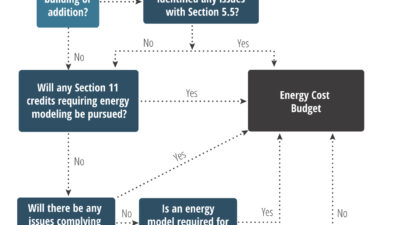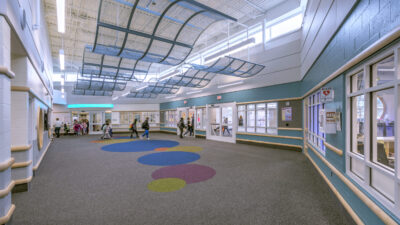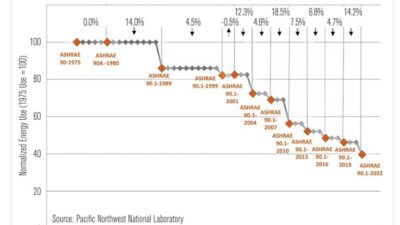Despite higher first cost, continuing technology advances and increasing system efficiencies are making geothermal a serious contender in the HVAC market.
CSE: What’s the latest with geothermal technology? Do recent advances promise to make geothermal systems even more efficient and cost-effective?
TOWNSEND : Increased geothermal unit efficiencies coupled with variable-speed pumps for the loops are helping to minimize energy consumption. Also, the new SEER 13 requirements should help make geothermal systems more attractive in terms of overall operational efficiencies and costs.
SCHMIDT : The latest geothermal advance seems to be with the refrigerant conversion from R-22 to R-410a. With R-410a now being used at a higher pressure, this is resulting in increased heat pump efficiencies and, consequently, lower energy costs.
HAMMOND : In my opinion, the latest technology innovations are all about compressors. For example, Copeland’s new UltraTech has simplified the two-speed compressor situation and made it a lot more reliable. While efficiency in dollars for the end user—whether it’s a two-speed system or not—is minimal, the advantage of the two-speed in sizing is a great comfort feature.
CSE: Geothermal systems are generally praised for their efficiency, and hence, long-term savings. But does the issue of first cost often derail potential projects?
TOWNSEND : Most definitely. Primarily due to the emphasis that owners often place on short-term returns on investment, perceived lower first cost for conventional systems has been a stumbling block for geothermalprojects.
SCHMIDT : First cost does discourage a large number of building owners from pursuing this type of project, and this is especially true of owners who roll the utility costs into tenant leases or don’t plan to occupy the building beyond five to 10 years. However, some utility companies are beginning to offer rebates based on system efficiency to help offset the first cost.
POPE : Just looking at the initial numbers, the first cost of, say, a ground-coupled heat-rejection component of a water-source heat-pump system can be three to four times more expensive than a cooling tower. So it’s really imperative to work with owners who are first-cost sensitive, to demonstrate the long-term value and cost efficiencies of a geothermal unit. This may require a life-cycle analysis, which may help them recognize that the system can pay for itself.
CSE: With the signing of the Energy Policy Act of 2005, what specific incentives are offered for commercial geothermal projects? In your opinion, do you think the passage of this federal legislation will ultimately make a significant impact on the use of renewable energy resources in the U.S.?
TOWNSEND : The basic incentives are up to $1.80 per sq. ft. for buildings that are at least 50% more efficient than minimum code requirements. These incentives can be divided into thirds for HVAC systems, lighting and building shell improvements. There are also credits available for residential and commercial solar systems, but the critical aspect of these incentives is the time frame that they must be implemented within. Because it is a short-term incentive program, it will, unfortunately, limit the overall impact of this legislation on the use of renewable systems in the U.S.
POPE : There are also some specific commercial tax changes relative to using geologic geothermal for heat or power generation, but this builds on pre-existing legislation covering this area and is very complex. While it is a step in the right direction, the Energy Policy Act of 2005 is a very complicated document, and because of the complexities, I don’t believe it will promote the specification of such systems.
SCHMIDT : Taking a look at the big picture, the passage of this legislation is another stepping stone for sustainable design, which is continually gaining popularity and momentum. In effect, legislation like this helps to increase awareness even more.
CSE: Where does geothermal fit in with LEED?
POPE : It’s important to make a distinction between “geological” geothermal and geothermal heat pumps. Many owners believe that ground-source heat pumps are synonymous with geological geothermal units.
In western states, geological geothermal systems use naturally occurring hot springs or steam, while in the northern states they use naturally occurring cold groundwater. These types of systems are considered sustainable and are recognized as such in the U.S. Green Building Council’s LEED rating system.
CSE: Does geothermal qualify for specific LEED credits?
POPE : According to version 2.2 of the LEED reference guide, geothermal heat pumps—sometimes referred to as earth-coupled, ground-source or water-source heat pumps—are not recognized as being sustainable. Under ideal conditions, however, they provide heat or cooling more efficiently than comparable systems by using the earth as a heat source or sink depending on the season.
In addition, some heat-pump systems are disqualified by LEED if they require a refrigeration cycle, which has an ozone-depletion component. The challenge here is that the most common units use R-22 refrigerant.
CSE: What kinds of stipulations within local codes can deter geothermal projects? Is there a good way to navigate around these?
POPE : While many states and localities have regulations in force for protecting groundwater or aquifers, they vary greatly. The U.S. Environmental Protection Agency also has its Safe Drinking Water Act. This being the case, the best way to avoid challenges is to create a closed system that keeps heat exchange fluid contained, thus eliminating the possibility of groundwater contamination.
TOWNSEND : Some local and state codes wrongly classify geothermal boreholes as wells, which creates considerable problems for loop contractors. As a result, considerable work and educational efforts are required to overcome the misperceptions of local and state officials.
CSE: Besides local codes and first cost, what other aspects of geothermal systems can sometimes discourage their use on a project?
HAMMOND : Fortunately, there aren’t nearly as many hurdles now as there were in the past. With the rising cost of fossil fuel, end users are seeing the benefits in payback, comfort and environmental friendliness.
SCHMIDT : Even so, one aspect that may discourage building owners from pursuing a geothermal project is the amount of land required for the well field.
TOWNSEND : A major factor that discourages implementation is a general misunderstanding of the overall system and operation and its inherent management benefits. Other problems can include unknown drilling conditions for a site, lack of competent drilling contractors and a lack of knowledgeable contractors to interface with loop contractors.
CSE: What are some common mistakes made when designing a geothermal system to heat/cool a facility? How can these be avoided?
TOWNSEND : Common mistakes include:
-
Failure to perform a thermal conductivity test for a sample borehole for proper loop sizing.
-
Improper spacing of the geo-field components—vertical or horizontal—or incorrect application of pond-, lake- or river-based geothermal systems.
-
Incorrect sizing of loop components, which are either too long or too short for the respective design loads.
-
Incorrect design loads used in sizing geothermal loops.
-
Incorrect allowance for thermal expansion of geothermal loop piping inside of buildings.
-
Insufficient specifications for grout type and installation and loop-pressure testing.
CSE: So how do you avoid these problems?
TOWNSEND : Attending educational sessions or courses from ASHRAE is a good way to avoid these mistakes. Using a mentoring consultant during the design sequence and utilizing design assistance provided by utilities is another good idea. Also, it’s important for an HVAC system designer to admit a lack of experience in geothermal-based designs and seek out the necessary guidance in order to produce a good system design.
HAMMOND : In my experience, proper sizing and proper loop sizing/installation are the biggest issues. Too many people are still using “rule of thumb” to size and install projects. Simply choosing a vertical loop when a pond could be used sends many jobs over budget. The best way to avoid this problem is to hire someone, preferably a certified geothermal designer, to design the loop. A good mechanical engineer can handle the load sizing, but the loop is best left to one who has specific experience and education in sizing a geothermal loop project.
SCHMIDT : Another important factor is to have accurate test bore data for ground loop projects. If the thermal conductivity of the soil is off, it has a large impact on the sizing of the well field. In addition, another item that is sometimes overlooked is the service clearance requirements for the heat pumps inside the building. This can easily be avoided by including the required clearance areas in the design.
POPE : A common problem I see is the gap between understanding geothermal technology and fully integrating a system into the larger facility design. Consequently, research is the key to avoiding mistakes. It’s vital to understand the technology, its benefits and any deterrents to potential problems. While there are no guarantees that underground obstacles can be completely avoided, soil testing and test-well digging will help owners understand if the site is suitable for geothermal systems. It’s also helpful to use proven companies and proven technology to ensure the best results.
CSE: Are there certain geographic areas or climates where geothermal makes more sense?
SCHMIDT : Most often it’s the soil type or ground makeup that determines the feasibility of a geothermal system when utilizing a ground loop heat exchanger.
POPE : Geothermal systems that take advantage of geologically occurring hot springs are most common in the western United States, with a few isolated areas in the East. The geographic areas best suited for the installation of geothermal heat pump heating and cooling systems are generally those that offer a balance of hot and cold temperatures in the central latitudes of the United States. That said, there are areas in Florida, for instance, with underground rivers that are ideally suited for geothermal systems, because the natural water flow carries away the rejected heat.
TOWNSEND : The best application is for a site where balanced heating and cooling loads exist. However, any region or climate can economically utilize geothermal if the systems are properly sized, thanks to increased utility costs throughout North America. But in general, areas having high annual water tables or solid rock strata are preferred over areas where the earth composition is questionable or has the potential of caverns or sinkholes.
Participants
Jay A. Hammond
Manager
Geothermal Design Assocs.
Fort Wayne, Ind.
David Pope, P.E.
Sr. Mech. Engineer
Heery International
Atlanta
Martin Schmidt, P.E., LEED AP
Manager, Mechanical Engineering
The Schemmer Assocs.
Omaha, Neb.
Terry Townsend, P.E.
President Townsend Engineering
Chattanooga, Tenn.
Changing Heat Into Electricity
According to a Sept. 21 story in the online edition of MIT’s Technology Review (
UTRC has developed a modular, 200-kW power plant that converts temperatures as low as 165°F into electricity by using steam or hot water to vaporize a hydrofluorocarbon refrigerant that drives a turbine. The refrigerant has a lower boiling point than water.
UTC is testing the system at a site in Alaska, which has more geothermal resources than any other state in the U.S. Curiously, none of these resources have been developed for power generation prior to 2006. But back in 2004, Alaska’s Chena Hot Springs Resort entered into a partnership with UTC to demonstrate the latter’s moderate-temperature geothermal ORC power plant technology.
The UTRC geothermal plant is a kind of reverse cooling system, with a turbine that works as a refrigerator compressor—except that it runs backwards. The difference is that instead of using power to create a temperature difference, the system converts a temperature difference into electricity.
Chena Hot Springs is said to be the lowest temperature geothermal resource in the world to be used for power production. It is anticipated that the cost of power production in Chena will drop from $0.30 to less than $0.07 per kWh. And this is always the challenge for for moderate temperature small-scale geothermal development is cost: how to develop small, economical geothermal fields.
Geothermal and EPAct 2005
The Energy Policy Act of 2005, signed into law by President Bush at Sandia National Labs in Albuquerque on Aug. 8, 2005, provides a number of new incentives for geothermal.
Officials at the Geothermal Heat Pump Consortium, Washington, D.C., point to a number of items. For example, Sec. 206, which covers renewable energy security, offers a 25% rebate, up to $3,000, for renewable energy systems that “(i) when installed in connection with a dwelling, transmits or uses- (I) solar energy, energy derived from the geothermal deposits, energy derived from biomass, or any other form of renewable energy [that] the Secretary specifies by regulations, for the purpose of heating or cooling such dwelling or providing hot water or electricity for use within such dwelling…”
The Consortium reports that it is working to ensure geothermal is not excluded from this definition.
Another section of the legislation relevant to geothermal awards commercial buildings deductions of up to $1.80 per sq. ft. for achieving a 50% reduction in annual energy cost to the user, with partial credits offered at $0.60 psf. This reduction amount is compared to a base building defined by the industry standard ASHRAE/IESNA 90.1-2001.
Finally, there are provisions for research and development funding through the U.S. Dept. of Energy. A full copy of the legislation can be downloaded at



